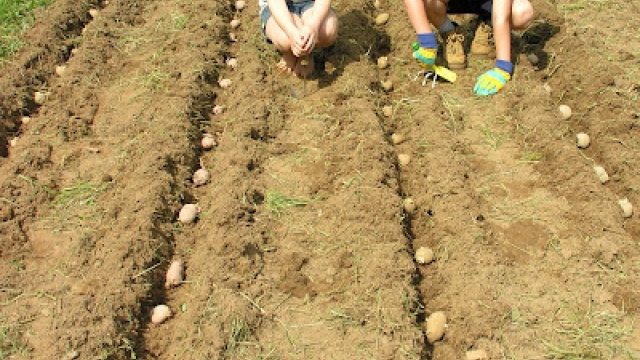Potato Planting: A Closer Look at the Art of Growing Potatoes
Are you ready to embark on a journey of potato planting? Before we dive into the depths of this fascinating art, let’s take a moment to appreciate the humble potato. This starchy tuber has long played a significant role in our diets, serving as a staple food for numerous cultures worldwide. But have you ever wondered what it takes to grow these versatile spuds?
Potato planting is more than just placing a seed in the ground; it requires careful thought and planning. From selecting the right seed potatoes to providing optimal growing conditions, every step contributes to a successful harvest. By delving into the intricacies of potato planting, we can uncover tips and techniques that will help us yield a bountiful crop.
One aspect worth considering is the concept of potato companion plants. Just as we humans thrive and support one another in harmonious relationships, certain plants can do the same for potatoes. These companions can provide benefits such as deterring pests, improving soil health, and optimizing space utilization. By exploring these symbiotic partnerships, we can unlock the potential for healthier potato plants and a more abundant harvest.
So, are you ready to strap on your gardening gloves and delve into the world of potato planting? Let’s dig in, quite literally, and discover the secrets behind cultivating these delightful tubers. From understanding their life cycle to mastering essential techniques, this article will equip you with the knowledge you need to become a potato planting extraordinaire. Let’s get started!
Tips for Successful Potato Planting
Choose the Right Seed Potatoes
Selecting high-quality seed potatoes is essential for successful potato planting. Look for certified disease-free varieties from reputable suppliers. Opt for potatoes that are firm, uniform in size, and free from blemishes or sprouts. Avoid using potatoes from the grocery store as they may have been treated with chemicals to prevent sprouting.Prepare the Soil Properly
Before planting your potatoes, it’s crucial to prepare the soil adequately. Potatoes thrive in loose, well-drained soil rich in organic matter. Start by removing any weeds and rocks from the planting area. Loosen the soil with a garden fork or tiller, breaking up clumps and ensuring good aeration. Consider adding compost or well-rotted manure to improve soil fertility.Practice Crop Rotation and Companion Planting
To minimize the risk of pests and diseases, it’s wise to practice crop rotation and companion planting with your potatoes. Avoid planting potatoes in the same spot more than once every three years, as this can lead to a buildup of pests and soilborne diseases. Additionally, consider planting potato companion plants such as marigolds, beans, or corn, which can help deter pests and provide beneficial interactions.
Remember, these tips are just the starting point for successful potato planting. Throughout the growing season, monitor your plants for signs of pests or diseases and take appropriate action. By giving your potatoes the right conditions and care they need, you’ll increase your chances of a bountiful harvest.
Companion Plants for Growing Potatoes
Potatoes thrive when planted alongside certain companion plants that can provide various benefits. These companion plants help deter pests, improve soil health, and enhance the overall growth and yield of the potato plants. Here are three such companion plants to consider when planting potatoes:
Organic Soil
Marigolds: Marigolds are excellent companion plants for potatoes due to their ability to repel pests, particularly nematodes and certain harmful insects. The strong scent emitted by marigolds acts as a natural deterrent, helping to protect potato plants from potential damage. Additionally, marigolds attract beneficial insects such as ladybugs, which in turn feed on harmful pests, creating a more balanced ecosystem in your potato garden.
Horseradish: Horseradish is known for its allelopathic properties, meaning it releases chemical compounds that can inhibit the growth of weeds and suppress certain soil-borne diseases. When planted alongside potatoes, horseradish acts as a natural weed suppressor, reducing competition for nutrients and space. This allows the potato plants to thrive without being overshadowed by invasive weeds. Furthermore, the pungent smell of horseradish can help repel certain pests, contributing to a healthier potato crop.
Beans: Beans, such as bush beans or pole beans, make fantastic companion plants for potatoes. These leguminous plants have the unique ability to fix nitrogen from the air into the soil, enriching it with this essential nutrient. Potatoes, being a heavy feeder, greatly benefit from the increased nitrogen availability which promotes vigorous growth and higher yields. As an added bonus, the vertical growth habit of pole beans can provide shade for the potato plants, preventing excessive sunlight exposure and reducing weed growth.
By strategically incorporating these companion plants into your potato garden, you can create a more sustainable and thriving ecosystem. Not only will they help deter pests, suppress weeds, and enhance soil fertility, but they will also contribute to healthier and more abundant potato harvests. Experiment with different combinations of companion plants to find the ones that work best for your specific gardening conditions and preferences.
Common Mistakes to Avoid When Planting Potatoes
- Lack of Proper Soil Preparation
One of the common mistakes made when planting potatoes is a failure to properly prepare the soil. Potatoes thrive in loose, well-drained soil that is rich in organic matter. Before planting, it is essential to till the soil and remove any rocks or debris that may impede root growth. Additionally, incorporating compost or well-rotted manure into the soil will provide the necessary nutrients for the potatoes to grow healthy and strong.
- Planting Potatoes Too Deep or Shallow
The depth at which potatoes are planted plays a crucial role in their growth and development. Planting them too deep can result in delayed emergence and weak sprouts, while planting them too shallow may expose the tubers to excessive sunlight, turning them green and toxic. To ensure optimal growth, plant potato pieces or seed potatoes at a depth of approximately 4-6 inches, covering them with the prepared soil.
- Neglecting Proper Spacing and Companions
Spacing is another vital consideration when planting potatoes. Planting them too close together can lead to overcrowding, restricted airflow, and increased susceptibility to diseases. Adequate spacing allows each potato plant to develop a strong root system and promotes healthier overall growth. Additionally, considering compatible companion plants such as beans and corn can enhance potato growth by warding off pests and improving soil fertility.
By avoiding these common mistakes, gardeners can greatly increase their chances of successful potato planting and ultimately enjoy a bountiful harvest.

